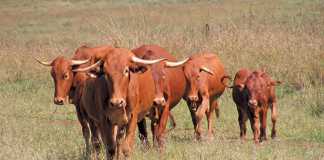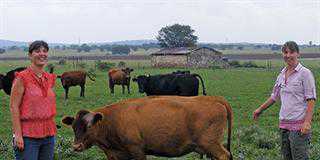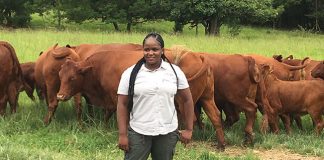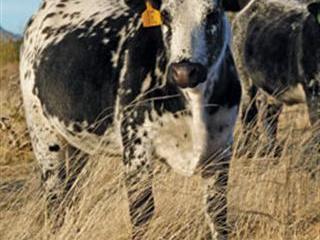
Nguni cattle came to the Mostert family in 1998 when Wimpie’s father Jaap was looking for an Nguni bull to solve calving problems in his small dairy herd on the farm Brabant near Bloemfontein. His search took him to Schalk van der Walt’s Gelykfontein Nguni Stud in the dry country around Venterstad in the Eastern Cape. Jaap was amazed at the condition of Schalk’s Ngunis and bought a bull and five old cows, the nucleus of what would become the Inyumba Nguni Stud.
“When he arrived at Schalk’s farm he saw the cattle were fat,’’ recalls Wimpie. “Then the Nguni bug bit him.” The Inyumba Stud was registered in 1999 and has been moulded by acquisitions from herds across South Africa and Namibia since then.
Today Wimpie and his brother-in-law Chris Fourie, who farms near Petrusberg in the Free State, share the responsibility for about 450 Inyumba Nguni breeding females.
Grazing upwards
In 2004, the day after he had graduated with a degree in agriculture, Wimpie drove to Lady Grey to start farming. Part of the Nguni stud had been moved from the Free State farm Jaap’s farm Cloebert in the Witteberg mountains of the Eastern Cape. Wimpie took over 160 breeding cows on the 2 200ha spread of land. Wimpie, now the chairperson of the East Cape Nguni Club, says that although the farm historically had good grass cover, it had been overgrazed for several years before his arrival.

Wimpy Mostert
The best grazing was high up on the slopes and summit of the Witteberg. It was crucial that the Ngunis could negotiate the slopes and reach places that were difficult to get to on the farm. “The cows grew out smaller as they adapted to the low temperatures and the mountainous terrain,” says Wimpie. “Larger animals tend to fall out of the system.” He is pleased with the way the cattle have utilised marginal grazing and have reached the more inaccessible veld areas on Cloebert.
“I don’t find them at the bottom of the mountain,” he admits. “I have to go and fetch them from the top.” Cows weighing between 380kg and 420kg receive a protein lick in winter, and salt and phosphate in summer. They calve on the veld, without assistance. The oldest producing cow in the herd is 16; the 20-odd replacement heifers are mated at between
18 months and 24 months depending on the season.
The transition from the Free State plains to the mountain sourveld and mixed veld of Cloebert has had its own challenges, including the problem posed by toxic plants such as the Senecio species. “There is a lot of it in this veld,” he explains, “and we lost animals to Senecio poisoning when we first moved here.”
Mating heifers
Breeding females are divided into five single-sire breeding herds. Four of the bulls have been bred in the herd and one has been bought in. “If we buy or exchange a bull, it is normally an older animal,” Wimpie says. “We establish his value by looking at his progeny. We don’t buy unproven young bulls, as we might then just as well use our own.” There is no defined breeding season for the bulk of the herd, but heifers are mated to calve from September to November. This diminishes the impact a harsh winter can have on first calvers in the Witteberg.
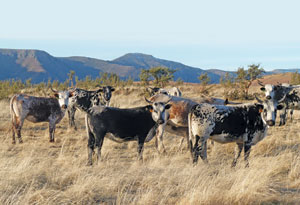
A group of Inyumba Nguni cows and heifers in the Witteberg near Lady Grey, Eastern Cape.
“A heifer calving in winter battles to put on condition post-calving and may fail to reconceive that season.” The heifers – with an average calving rate of 95% last year – are run for one to two hours a day on part of a 30ha block planted to oats (27ha) and lucerne (3ha), used mainly for sheep, throughout the calving season.
About 40 registered and 20 commercial female animals, roughly 90% of them in calf, are sold annually at auctions including the Eastern Cape Nguni Club Sale. Every year, 10 Inyumba bulls are selected on Cloebert; the rest are sold as weaners off the veld. Highest Inyumba Nguni prices achieved include a pregnant heifer sold for R25 500 in 2006 and a bull sold for R42 500 in 2005.
Commercial ngunis
“I work in terms of kilograms per hectare, not kilograms per individual animal,” says Wimpie, explaining the value of Ngunis to a commercial cattleman. “If you look at production per hectare, Ngunis are more productive. The fertile, hardy Nguni allows an extensive, no-fuss approach. Weaners are smaller, averaging between 150kg and 180kg at seven months, and are marketed off the veld at 10 months to 12 months.”
Wimpie explains that the Mosterts have never had a problem selling weaners, although they compete in the feedlot market with larger breed weaners. Dehorning is important for the feedlot market and takes place at seven months, after weaning.
The Nguni is valuable in terms of terminal cross-breeding, Wimpie says. “Keep a pure-bred Nguni herd to breed replacement heifers, and use an Angus or Charolais bull on Nguni cows,” he suggests. “If the progeny are all destined for slaughter, there is no danger of cross-bred dams being retained in the herd and the advantages of terminal cross-breeding are not lost.”
Contact Wimpie Mostert on 083 235 3580.











